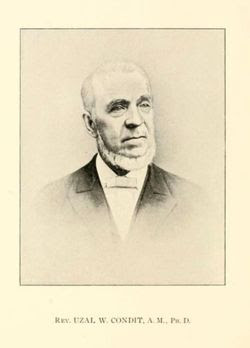James Bernard O'Hay was, according to his obituary, "Prominent Easton Business Man" and one of Easton's best known citizens. He was born in South Easton in 1867 and grew up on the long gone Apricot alley. James was the saloon/cafe owner of O'Hay's from 1895 to 1920, located on Centre Square. Later, he was owner of United Furniture Company, engaged in the automobile business, and finally ending his career in real estate. He was also active in Democratic politics, attending State and National conventions. He married Julia Reilly at St. Bernard's Catholic Church, Easton, PA on May 2, 1894. Together, they had two daughters, Kathryn Elizabeth, born December 7, 1894 and Anne Julia born 1899.
When Kathryn was born, the family was living at 325 Spring Garden St. in Easton. The house is no longer there and is a parking lot for a bank today. James was listed as a saloonkeeper on Centre Square. By the time Kathryn was at Taylor grade school in 1901, the family was living at 108 South Third St. Kathryn graduated from the Easton High School in 1912. In school, Kathryn was manager of the Girl's Basketball team, was on the Athletic Association Advisory Board, the Girls' Double Octette, and enrolled in "Latin Scientific"
Some time after graduating from High School in 1912, Kathryn graduated from Mount St. Joseph Collegiate Institute, now Chestnut Hill College in Philadelphia, PA where she majored in sociology. (The Institute was founded in 1924.)
On June 2, 1916, Kathryn O'Hay married Joseph B. McNally at St. Bernard's Catholic Church, now Our Lady of Mercy. Unfortunately, Joseph B. died suddenly Jan. 15, 1934 at a hotel in Youngstown, OH, while on a business trip. He is buried at Gethsemane Cemetery, Easton, PA. Kathryn and Joseph had no children.
Kathryn's mother, Julia, died March 19, 1918. Her father, James B. died June 4, 1942. Both are buried at Gethsemane Cemetery.
In the 1940 Federal Census Kathryn is still living with her father in Easton and is a State Relief Investigator. By the 1950 Federal Census, she is married to Congressman William T. Granahan in Philadelphia, PA. Granahan was a Democratic politician from the U. S. of Pennsylvania, most prominently serving in the U. S. House of Representatives from 1945–47 and 1949-56.When he passed away on May 25, 1956, Kathryn was elected by special election to fill the vacancy caused by his death. William was buried at Gethsemane Cemetery.
Kathryn was a Democrat like her father and husband and served five years in Congress, being the first woman ever elected from her state. Kathryn was appointed by President John Kennedy to be the Treasurer of the United States and served from January 1963 until November 1966.
Kathryn was the fourth straight woman to take the oath of office for treasureship. This is not to be confused with the position of secretary of the treasury, then held by Douglas Dillon. *The Treasurer of the United States is an official within the Department of the Treasury who, along with the Secretary of the Treasury, has their signature appear on all U.S. paper currency. Currently, the Treasurer's duties also include:
- Direct oversight of the U.S. Mint and the Bureau of Engraving and Printing.
- Serving as a key liaison with the Federal Reserve.
- Acting as a senior advisor to the Secretary of the Treasury in areas of community development and public engagement.
- Leading the Office of Tribal and Native Affairs, which coordinates Tribal relations across the Department.
- The position of Treasurer is the only office in the Treasury Department that is older than the Department itself, having been established by the Continental Congress in 1775.

.jpg)

.jpg)


























.jpg)

